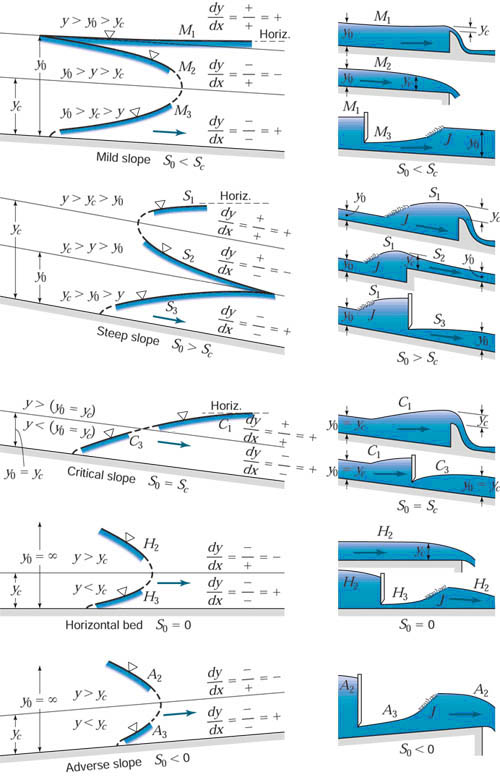To study water surface profiles on mild slope
Objectives:
- To set the mild slope in S6 tilting flume
- To observe M1 & M3 profiles in flume when sluice gate is provided.
- To draw water surface profiles when sluice gate is provided in flume.
Apparatus:
- S6 tilting flume
- Point gauge
- Sluice gate
Related theory:
Gradually varied flow:
If the flow depth varies at slow rate with respect to distance then the flow is called gradually varied flow.
Rapidly varied flow:
If the flow depth varies significantly in a short distance then the flow is called rapidly varied flow.
Governing equation for gradually varied flow:
The gradually varied flow equations in a prismatic channel having no lateral inflow or outflow are derived in this section by making the following simplifying assumptions:
- The slope of the channel bottom is small.
- The channel is prismatic channel and there is no lateral inflow or outflow from the channel.
- The pressure distribution is hydrostatic at all channel sections.
- The head losses in gradually varied flow may be determined by using the equations for head losses in uniform flows.
The governing equations for G.V.F are given below:

Classification of water surface profiles:
Channel-bottom slopes are classified into the following five categories:
Mild, steep, critical, horizontal (zero slope) and adverse (negative slope). The first letter of these names refers to the type, i.e., M for mild, S for steep, C for critical, H for horizontal and A for adverse slope.
The bottom slope of a channel is called as mild slope if the uniform flow is subcritical (i.e., yn > yc); for the specified discharge and Manning n; it is critical slope if the uniform flow is critical (i.e., yn = yc); and it is steep slope if the uniform flow is supercritical (i.e., yn < yc). It is apparent that the normal depth is infinite if the bottom slope is horizontal and it is nonexistent if the bottom slope is negative. To summarize, the channel bottom slope is called
- mild if yn > yc;
- steep if yn < yc; and
- critical if yn = yc.
Note:
If surface profile lies above both lines i.e. yo and yc, it is called type 1 profile
If surface profile lies between these lines i.e. yo and yc, it is called type 2 profile
If surface profile lies below both lines i.e. yo and yc, it is called type 3 profile
Observations:
All type 1 surface water profiles are formed due to dams or weirs.
All type 2 surface water profiles are formed due to brink.
All type 3 surface water profiles are formed due to sluice gate on downstream.
Mild slope:
When slope of channel is mild then,
So<Sc
yn>yc
Zone 1 (M1 Profile)
Since y>yo>yc in zone 1, the numerator is + and denominator is also +, hence the slope of surface profile in zone 1 is increasing.

Zone 2 (M2 Profile)
Since yo>y>yo in zone 2, the numerator is + and denominator is also -, hence the slope of surface profile in zone 1 is decreasing.

Zone 3 (M3 Profile)
Since yo>yc>y in zone 3, the numerator is – and denominator is also -, hence the slope of surface profile in zone 1 is increasing.

Water surface profiles on different slopes along with practical application

Procedure:
- Set some suitable value of slope in flume, this slope should be mild slope (this will be confirmed by calculating whether yn>yc or not)
- Allow discharge in the flume and note its value.
- By using manning’s equation find the normal depth in the flume using the fixed discharge value.
- Also find the critical depth using the fixed discharge value.
- Check whether yn>yc or not, if this is satisfied then this will be the mild slope and now we can measure the depth of water.
- Measure the water surface profiles by changing the 4 gate openings of sluice gate. 2 readings at <yc, 1 at yc, and 1 at >yc.
- Draw water surface profiles at various gate openings.
Observations and Calculations
Q= 0.012958 m3/s
b= 300 mm
Slope 1:500
Sluice gate is provided at 4.85 m
Finding normal depth:

As yn>yc, hence mild slope confirmation.
Readings of water depths:
| Gate opening | <yc | <yc | yc | >yc |
| 30 mm | 40 mm | 57.5 mm | 62.5 mm | |
| Distances | Depths | |||
| x | y | y | y | y |
| mm | mm | mm | mm | mm |
| 3000 | 168 | 112 | 69 | 69 |
| 3500 | 189 | 113 | 72 | 69 |
| 4000 | 207 | 116 | 75 | 74 |
| 4500 | 230 | 119 | 76 | 76 |
| 4750 | 242 | 120 | 79 | 76 |
| 5000 | 13 | 27 | 70 | 71 |
| 5500 | 14 | 27 | 72 | 73 |
| 6000 | 15 | 34 | 72 | 73 |
| 7000 | 20 | 42 | 73 | 75 |
| 7500 | 23 | 57 | 71 | 72 |
| 8500 | 52 | 67 | 67 | 68 |




Conclusions:
- The water surface profile M1 & M3 are formed on mild slope when sluice gate is provided at opening of sluice gate < yc
- Hydraulic jump is formed on downstream side of sluice gate when opening of sluice gate is < yc
